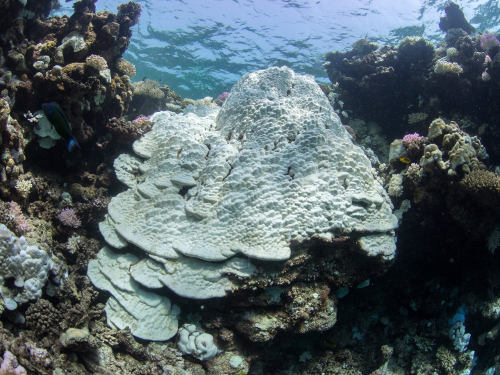Using AI to control energy for indoor agriculture
30 September 2024
Published online 6 March 2017
New study sheds light on bacterial community dynamics and patterns of corals' heat-resilience.

© Anna Roik
Chris Voolstra, associate professor of marine science, and his colleagues at King Abdullah University of Science and Technology (KAUST) have been studying patterns of coral heat tolerance and how bacteria sustain corals in warming waters.
The study, published in Nature Communications1, is a result of research on two sites which, despite their proximity, sustain corals that behave very distinctly.
“While you can swim from one site to the other,” explains Voolstra, “one pool is highly variable (HV) with a wider spectrum of water temperature, and the other is moderately variable (MV).” This variation is caused by the tide, which affects the two pools differently.
The vulnerability and resilience of corals have been a source of fascination and study for marine biologists worldwide. Often referred to as 'tropical rainforests of the sea', the complex ecosystems they construct are teeming with life and have carpeted marine seabeds for 250 million years.
Corals survive thanks to a delicate symbiotic balance between a coral animal, an algae and a diverse bacterial community; this equilibrium is threatened by global warming, pollution, overfishing and coastal development. While marine biologists now have a finer understanding of the synergic relationship between algae and coral animals, the role played by bacterial communities in this multi-partner symbiosis has not been determined.
The scientists reciprocally transplanted corals between the two pools for 17 months; introducing sensitive corals from the MV pool into the stressful HV environment, and immersing resilient corals into a hospitable environment. “What we showed is that the corals completely adjusted their associated bacteria, which suggests that whatever environment you put the coral in, the microbiome adapts in this coral species,” Voolstra says.
On one end of a continuum are the corals that fare poorly when faced with new conditions, and on the other end are weedy corals that do well everywhere.
They conducted a second experiment, exposing corals from the HV and MV pools to a short heat stress test to assess resilience or lack thereof in response to sudden warmth.
“The results were very exciting: we were able to demonstrate that the bacteria associated with the resistant corals were unchanged and expressed functions previously linked to thermo-tolerance, whereas the delicate corals' bacteria showed functions associated with sensitivity,” explains Voolstra.
To make the case that a specific bacterium is implicated in the process, it would need to be isolated, transplanted, show it changed functions, and eventually re-isolated from the new host. “This is the part we haven't done yet but are currently working on in the Red Sea,” he says.
Emily Howells is an Australian marine biologist doing a postdoc at the New York University Abu Dhabi (NYUAD) to try and identify unique characteristics of corals living in high temperature waters. She did not participate in Voolstra's study, but is excited by its results. “We already knew that the coral animal and the algae play a very strong role in determining the physiology and stress tolerance of corals,” she says. “However, the specific roles of the bacteria have not been completely determined, so it is really exciting to see this study come out."
The study suggests that microbial adaptation constitutes another possible mechanism to counteract the effects of environmental change. But as Howells points out, “when you put a coral into a warmer environment, it can quickly take up a very different set of bacteria, and the symbiosis as a whole gains in thermo-tolerance. But, because the symbiosis can be thermo-tolerant, it can be difficult to pinpoint whether that's due to the bacteria itself or to some other mechanisms of acclimatization that could be within the coral animal, or within the algae.”
The next step for Voolstra is to find out if the Red Sea has more of those bacteria associated with corals, and determining the biological cost paid by harboring them.
Different coral species express a varying degree of flexibility and adaptation to warmer conditions, says the researcher. The coral Acropora hyacinthus they studied in Samoa, which is also present in the Red Sea, proved to be flexible; its associated bacteria quick to adjust to a new environment.
There are two types of corals, adds Voolstra. On one end of a continuum are the corals that fare poorly when faced with new conditions, and on the other end are weedy corals that do well everywhere, and have potentially better long-term survival.
“We are associating these traits with the underlying microbiome flexibility to see what patterns emerge,” he explains. “What is the capacity of adaptation of the corals and their associated bacteria in an environment that's already extreme?”
Since the Red Sea has far more extreme conditions for corals, compared to Samoa, Voolstra hopes it will help them answer questions this experiment could not.
doi:10.1038/nmiddleeast.2017.42
Stay connected: